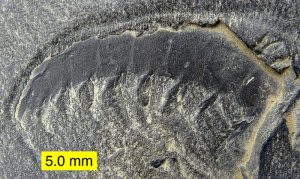We’ll spend Tuesday talking about scaphopods, rostroconchs, bivalves, and the hyolithids. Please review the past links. On Thursday we’ll have an introduction to the arthropods.
The Phylum Arthropoda is extraordinarily diverse. These are the animals that will inherit the world, if they haven’t already. Let’s first visit the wonderful and arthropod-rich Burgess Shale, courtesy of the Burgess Shale Geoscience Foundation. (Eight years ago I had my own visit to the Burgess Shale at the Walcott Quarry. Magnificent!) For serious work we hardly need to stray from the arthropod pages at Berkeley and the arthropod Wikipedia page. Please visit the Berkeley onychophoran page for a look at primitive arthropod characters. The trilobite pages are especially well organized. Concentrate on the agnostids and the polymerids (the redlichiids and phacopids being important here for us) An amateur paleontologist (Sam Gon III) has an excellent Guide to the Orders of Trilobites. We will not recognize all the orders, but the images and descriptions here are tremendous. You will also find excellent images of trilobites on the Wikipedia trilobite page. The most comprehensive set of trilobite images is courtesy of the American Museum of Natural History. We now have excellent evidence for trilobite eggs.
Take a look at this impressive eurypterid from the Mazon Creek Pennsylvanian. An excellent “eurypteridology” website is maintained by Samuel J. Ciurca, Jr. Katherine Marenco at Bryn Mawr (and a Wooster geology alumna) found this Eurypterid Tumblr page. To complete your set, please visit websites for the crustaceans, insects and arachnids.
You’re too young to remember the bizarre Sea Monkeys craze. It was based on the real science of brine shrimp and cryptobiosis. Who knew the story also involves racism and the KKK?
Thought you might like to see this YouTube video on the fossils below the Creation Museum in northern Kentucky. They will be familiar! You may want to see the related videos, like this one on Cincinnatian fossils. You can watch people digging for trilobites for fun and, apparently, profit. You get to do it for free!
Your next lab test is on Thursday, November 9. It will go through the scaphopods and rostroconchs.

Anomalocaridid “arm” from the Burgess Shale (Middle Cambrian), Walcott Quarry, British Columbia, Canada.
Geology in the News –
Here’s a nice octopus-like fossil from the Jurassic. It’s not often invertebrate paleontology makes the BBC news!
It’s not often I cite the Daily Mail here, but this is a good popular account of how volcanoes change climate, and why warmer oceans may increase the effects.
A 200-million-year-old “megacarnivore” new theropod dinosaur found, sort of. We only know its footprints, so Kayentapus is a trace fossil, not the actual dinosaur. Impressive nonetheless.
A new pterosaur was found (in part) in Mongolia. It is Late Cretaceous and had a wingspan of about 10 meters. It may have eaten baby dinosaurs!
